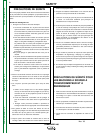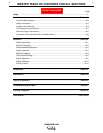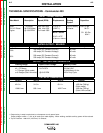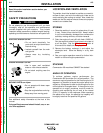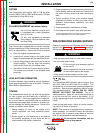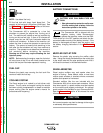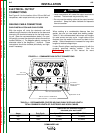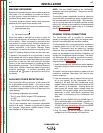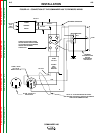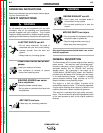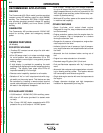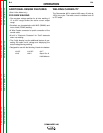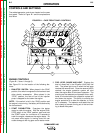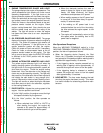
MACHINE GROUNDING
Because this portable engine driven welder creates its
own power, it is not necessary to connect its frame to
an earth ground, unless the machine is connected to
premises wiring (home, shop, etc.).
To prevent dangerous electric shock, other equipment
powered by this engine driven welder must:
a) be grounded to the frame of the welder using a
grounded type plug,
or
b) be double insulated.
When this welder is mounted on a truck or trailer, its
frame must be securely connected to the metal frame
of the vehicle. When connected to premises wiring
such as that in a home or shop, its frame must be con-
nected to the system earth ground. See further con-
nection instructions in the section “Standby Power
Connections” as well as the article on grounding in the
latest U.S. National Electrical Code and the local code.
In general, if the machine is to be grounded, it should
be connected with a #8 or larger copper wire to a solid
earth ground such as a metal water pipe going into the
ground for at least ten feet and having no insulated
joints or to the metal framework of a building that has
been effectively grounded. The U.S National Electrical
Code lists a number of alternate means of grounding
electrical equipment. A machine grounding stud
marked with the symbol is provided on the front of
the welder.
AUXILIARY POWER RECEPTACLES
The Commander 400 can produce 10,000 watts of 60
Hz, single-phase auxiliary power. (The rating in watts
is equivalent to volt-amperes at unity power factor.)
The output voltage is within ±10% at all loads up to the
rated capacity.
The following receptacles are provided:
• Two 15 amp-120VAC duplex GFCI receptacles
(5-15R)
• One 50 amp-120/240VAC receptacle (14-50R)
The 50 amp receptacle has a maximum permissible
output of 44 amps. However, it can be split to power
two separate, single-phase 120VAC branch circuits
each capable of 44 amps output.
NOTE: The two 120VAC outlets of the 120/240VAC
receptacle cannot be paralleled. They are on two dif-
ferent phases.
The auxiliary power receptacles should be used with
only three-wire, grounded type plugs or approved dou-
ble-insulated tools with two-wire plugs. The current rat-
ing of any plug used with the system must be at least
equal to the current-carrying capacity of the associated
receptacle. An optional power plug kit is available.
See the Accessories section.
STANDBY POWER CONNECTIONS
The Commander 400 is suitable for temporary,
standby or emergency power using the engine manu-
facturer’s recommended maintenance schedule.
The Commander 400 can be permanently installed as
a standby power unit for 240 volt 3-wire, 44 ampere
service. Connections must be made by a licensed
electrician who can determine how the 120/240 VAC
power can be adapted to the particular installation and
comply with all applicable electrical codes. The follow-
ing information can be used as a guide by the electri-
cian for most applications. Refer to the connection
diagram shown in Figure A.2.
1. Install the double-pole, double-throw switch between
the power company meter and the premises discon-
nect.
The switch rating must be the same or greater than the
customer’s premises disconnect and service over
current protection.
2. Take the necessary steps to assure the load is limit-
ed to the capacity of the Commander 400 by
installing a 45 amp, 240 VAC double-pole circuit
breaker. Maximum rated load for each leg of the 240
VAC auxiliary is 45 amperes. Loading above the
rated output will reduce output voltage below the
allowable -10% of rated voltage, which may damage
appliances or other motor-driven equipment and
may result in overheating of the Commander 400
engine.
3. Install a 50 amp 120/240 VAC plug (NEMA Type 14-
50) to the double-pole circuit breaker using No. 6, 4
conductor cable of the desired length. (The 50 amp,
120/240 VAC plug is available in the optional K802R
plug kit.) See the Accessories section.
4. Plug this cable into the 50 ampere 120/240 volt
receptacle on the Commander 400 case front.
INSTALLATION
A-7 A-7
COMMANDER 400
Return to Section TOC Return to Section TOC Return to Section TOC Return to Section TOC
Return to Master TOC Return to Master TOC Return to Master TOC Return to Master TOC



